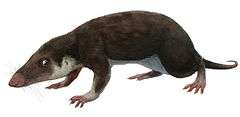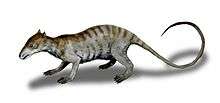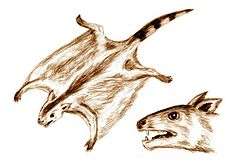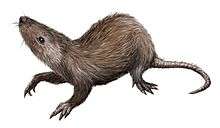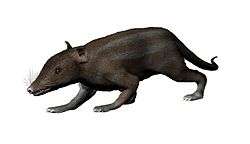Mammaliaformes
Mammaliaformes ("mammal-shaped") is a clade that contains the crown group mammals and their closest extinct relatives; the group radiated from earlier probainognathian cynodonts.[1] It is defined as the clade originating from the most recent common ancestor of Morganucodonta and the crown group mammals; the latter is the clade originating with the most recent common ancestor of extant Monotremata, Marsupialia, and Placentalia.[2] Besides Morganucodonta and the crown group mammals, Mammaliaformes includes Docodonta and Hadrocodium as well as the Triassic Tikitherium, the earliest known member of the group.[3][4]
| Mammaliaformes | |
|---|---|
 | |
| From top to bottom and from left to right: Castorocauda, Adelobasileus, Megazostrodon and Morganucodon. | |
| Scientific classification | |
| Kingdom: | Animalia |
| Phylum: | Chordata |
| Clade: | Therapsida |
| Clade: | Cynodontia |
| Clade: | Prozostrodontia |
| Clade: | Mammaliamorpha |
| Clade: | Mammaliaformes Rowe, 1988 |
| Subgroups | |
Mammaliaformes is a term of phylogenetic nomenclature. In contrast, the assignment of organisms to Mammalia has traditionally been founded on traits and, on this basis, Mammalia is slightly more inclusive than Mammaliaformes. In particular, trait-based taxonomy generally includes Adelobasileus and Sinoconodon in Mammalia, though they fall outside the Mammaliaformes definition. These genera are included in the broader clade Mammaliamorpha, defined phylogenetically as the clade originating with the last common ancestor of Tritylodontidae and the crown group mammals.[2] This wider group includes some families that trait-based taxonomy does not include in Mammalia, in particular Tritylodontidae and Brasilodontidae.
Animals in the Mammaliaformes clade are often called mammaliaforms, without the e. Sometimes, the spelling mammaliforms is used. The origin of crown-group mammals extends back to the Jurassic, with extensive findings in the Late Jurassic outcrops of Portugal and China.
Mammaliaformes in life
Early mammaliaforms were generally shrew-like in appearance and size, and most of their distinguishing characteristics were internal. In particular, the structure of the mammaliaform (and mammal) jaw and the arrangement of teeth are nearly unique. Instead of having many teeth that are frequently replaced, mammals have one set of baby teeth and later one set of adult teeth that fit together precisely. This is thought to aid in the grinding of food to make it quicker to digest.[5] Warm-blooded animals require more calories than those that are cold-blooded, so speeding up the pace of digestion is a necessity. The drawback to the fixed dentition is that worn teeth cannot be replaced, as was possible for the reptilian ancestors of mammaliaforms. To compensate, mammals developed prismatic enamel, characterized by crystallite discontinuities that helped spread out the force of the bite.[6]
Lactation, along with other characteristically mammalian features, is also thought to characterize the Mammaliaformes, but these traits are difficult to study in the fossil record. Evidence of lactation is present in morganucodontans, via tooth replacement patterns.[7] Combined with the more basal tritylodontids that also display evidence of lactation,[8] this seems to imply that milk is an ancestral characteristic in this group. However, the fairly derived Sinoconodon appears to have uniquely discarded milk altogether. Prior to hatching, the milk glands would provide moisture to the leathery eggs, a situation still found in monotremes.[9]
The early mammaliaforms did have a harderian gland. In modern mammals, this is used for cleaning the fur, indicating that they, contrary to their Cynodont ancestors, had a furry covering. An insulative covering is necessary to keep a homeothermic animal warm if it is very small, less than 5 cm (1.97 in) long;[10] The 3.2 cm (1.35 in) Hadrocodium must have had fur, therefore, but the 10 cm (3.94 in) Morganucodon might not have needed it. The docodont Castorocauda, further removed from crown group mammals than Hadrocodium, had two layers of fur, guard hairs and underfur, as do mammals today.[11]
It is possible that early mammaliaforms had vibrissae; Tritheledontidae, a group of Cynodonts, probably had whiskers.[12] A common ancestor of all therian mammals did so.[13] Indeed, some humans even still develop vestigial vibrissal muscles in the upper lip.[14] Thus, it is possible that the development of the whisker sensory system played an important role in mammalian development, more generally.[13]
Like monotremes today, the legs of early mammaliaforms were somewhat sprawling, giving a rather "reptilian" type of gait. However, there was a general tendency to have more erect forelimbs, forms like eutriconodonts even having a fundamentally modern forelimb anatomy while the hindlimbs remained "primitive";[15] this tendency is in some effect still seen in modern therian mammals, which often have more sprawling hindlimbs.[16] In some forms, the hind feet likely bore a spur similar to those found in the platypus and echidnas. Such a spur would have been connected to a venom gland for protection or mating competition.[17]
Hadrocodium lacks the multiple bones in its lower jaw seen in reptiles. These are still retained, however, in earlier mammaliaforms.[18]
With the possible exception of Megazostrodon and Erythrotherium (as well as placental mammals),[19] all mammaliforms possess epipubic bones, a possibly synapomorphy with tritylodontids, which also have them.[20] These pelvic bones strengthen the torso and support abdominal and hindlimb musculature. They, however, prevent the expansion of the abdomen, and so force species that possess them to either give birth to larval young (as in modern marsupials), or produce minuscule eggs that hatch into larval young (as in modern monotremes).[21] Most mammaliforms, therefore, probably had the same constraints, and some species could have borne pouches.
Phylogeny
The cladogram below follows the analysis of Luo and colleagues in 2015.[22]
| Mammaliamorpha |
| |||||||||||||||||||||||||||||||||||||||||||||||||||||||||||||||||||||||||||||||||||||||||||||||||||||||||||||||||||||||||||||||||||||||||||||||||||||||||||||||||||||||||||||||||||||||||||||||||||
Cladogram based on Rougier et al. (1996)[23] with Tikitherium included following Luo and Martin (2007).[3]
| Mammaliamorpha |
| |||||||||||||||||||||||||||||||||||||||||||||||||||||||||||||||
References
- Abdala, F. (2007). "Redescription of Platycraniellus Elegans (Therapsida, Cynodontia) from the Lower Triassic of South Africa, and the cladistic relationships of eutheriodonts". Palaeontology. 53 (3): 591–618. doi:10.1111/j.1475-4983.2007.00646.x.
- Rowe, T. S. (1988). "Definition, diagnosis, and origin of Mammalia" (PDF). Journal of Vertebrate Paleontology. 8 (3): 241–264. doi:10.1080/02724634.1988.10011708.
- Luo, Zhe-Xi; Martin, Thomas (2007). "Analysis of Molar Structure and Phylogeny of Docodont Genera" (PDF). Bulletin of Carnegie Museum of Natural History (39): 27–47. doi:10.2992/0145-9058(2007)39[27:AOMSAP]2.0.CO;2. Archived from the original (PDF) on 2016-03-03. Retrieved 2012-10-14.
- Datta, P. M. (2005). "Earliest mammal with transversely expanded upper molar from the Late Triassic (Carnian) Tiki Formation, South Rewa Gondwana Basin, India". Journal of Vertebrate Paleontology. 25 (1): 200–207. doi:10.1671/0272-4634(2005)025[0200:EMWTEU]2.0.CO;2.
- Minkoff, Edwin H. Colbert, Michael Morales, Eli C. (2001). Colbert's evolution of the vertebrates : a history of the backboned animals through time (5th ed.). New York: Wiley. ISBN 978-0-471-38461-8.
- Line, S. R. P.; Novaes, P. D. (2005). "The development and evolution of mammalian enamel: Structural and functional aspects" (PDF). Brazilian Journal of Morphological Sciences. 22 (2): 67–72. ISSN 0102-9010.
- Panciroli E., Benson RBJ., and Walsh S. 2017. The dentary of Wareolestes rex (Megazostrodontidae): a new specimen from Scotland and implications for morganucodontan tooth replacement. Papers in Palaeontology
- Hu, Yaoming; Meng, Jin; Clark, James M. "A New Tritylodontid from the Upper Jurassic of Xinjiang, China". Acta Palaeontologica Polonica. 54 (3): 385–391. doi:10.4202/app.2008.0053.
- Oftedal, O.T. (2002). "The mammary gland and its origin during synapsid evolution". Journal of Mammary Gland Biology and Neoplasia. 7 (3): 225–252. doi:10.1023/A:1022896515287. PMID 12751889.
- Ruben, J.A. & Jones, T.D. (2000). "Selective Factors Associated with the Origin of Fur and Feathers". American Zoologist. 40 (4): 585–596. doi:10.1093/icb/40.4.585.
- Qiang Ji; et al. (2006). "A Swimming Mammaliaform from the Middle Jurassic and Ecomorphological Diversification of Early Mammals". Science. 311: 1123–27. doi:10.1126/science.1123026. PMID 16497926.
- "Your Inner Fish: Episode Guide". PBS. 2014. Retrieved August 7, 2014.
- Mitchinson, B.; Grant, R. A.; Arkley, K.; Rankov, V.; Perkon, I.; Prescott, T.J. (12 November 2011). "Active vibrissal sensing in rodents and marsupials". Phil. Trans. R. Soc. B. 366 (1581): 3037–3048. doi:10.1098/rstb.2011.0156. PMC 3172598. PMID 21969685.
- Tamatsu, Yuichi; Tsukahara, Kazue; Hotta, Mitsuyuki; Shimada, Kazuyuki (August 2007). "Vestiges of vibrissal capsular muscles exist in the human upper lip". Clin Anat. 20 (6): 628–31. doi:10.1002/ca.20497. PMID 17458869.
- Zofia Kielan-Jaworowska, Richard L. Cifelli, Zhe-Xi Luo (2004). "Chapter 7: Eutriconodontans". Mammals from the Age of Dinosaurs: origins, evolution, and structure. New York: Columbia University Press. pp. 216–248. ISBN 0-231-11918-6.CS1 maint: multiple names: authors list (link)
- Kielan−Jaworowska, Z. and Hurum, J.H. 2006. Limb posture in early mammals: Sprawling or parasagittal. Acta Palae− ontologica Polonica 51 (3): 393–406.
- Hurum, J.H.; Luo, Z-X; Kielan-Jaworowska, Z. (2006). "Were mammals originally venomous?" (PDF). Acta Palaeontologica Polonica. 51 (1): 1–11.
- Kemp, T. S. (2005). The Origin and Evolution of Mammals. Oxford University Press. p. 149. ISBN 0-19-850760-7.
- Jason A. Lillegraven, Zofia Kielan-Jaworowska, William A. Clemens, Mesozoic Mammals: The First Two-Thirds of Mammalian History, University of California Press, 17/12/1979 - 321
- Stephen Reily and Thomas White, Hypaxial Motor Patterns and the Function of Epipubic Bones in Primitive Mammals, ARTICLE in SCIENCE 299(5605):400-2 · FEBRUARY 2003, Department of Biological Sciences, Ohio University, Athens, OH 45701, USA. Impact Factor: 33.61 · doi:10.1126/science.1074905 · Source: PubMed
- Michael L. Power, Jay Schulkin. The Evolution Of The Human Placenta. pp. 68–.
- Luo, Zhe-Xi; Gates, Stephen M.; Jenkins Jr., Farish A.; Amaral, William W.; Shubin, Neil H. (16 November 2015). "Mandibular and dental characteristics of Late Triassic mammaliaform Haramiyavia and their ramifications for basal mammal evolution". PNAS. 112: E7101-9. doi:10.1073/pnas.1519387112. PMC 4697399. PMID 26630008. Retrieved 17 November 2015.
- Rougier, G. W.; Wible, J. R.; Hopson, J. A. (1996). "Basicranial Anatomy of Priacodon fruitaensis (Triconodontidae, Mammalia) from the Late Jurassic of Colorado, and a Reappraisal of Mammaliaform Interrelationships" (PDF). American Museum Novitates. American Museum of Natural History (3183). ISSN 0003-0082.
